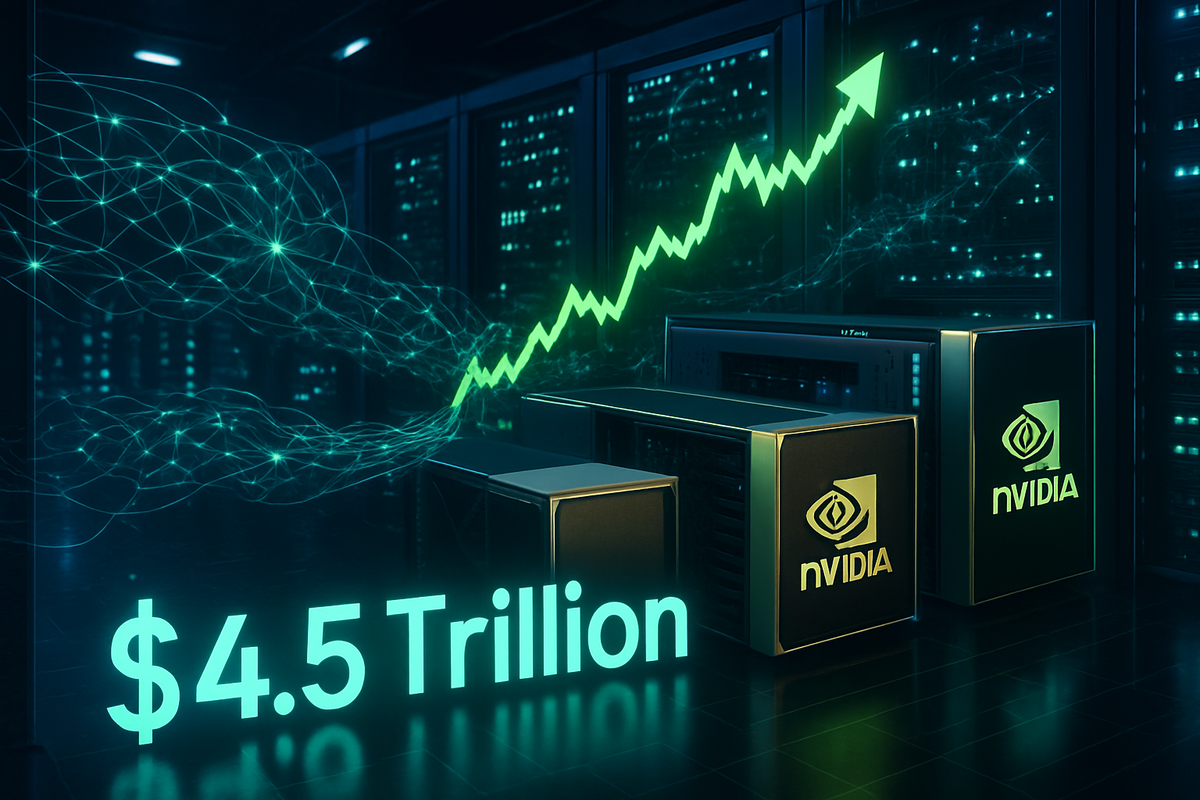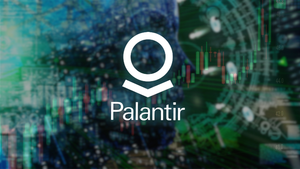
As of early October 2025, Nvidia (NASDAQ: NVDA) stands as the undisputed titan of the AI era, its stock performance reflecting an unparalleled surge fueled by insatiable demand for its cutting-edge AI hardware. The company has shattered records, achieving an unprecedented market capitalization of $4.5 trillion, cementing its position as the world's most valuable company. This meteoric rise, driven by strategic partnerships and the foundational role of its GPUs in global AI infrastructure, has seen its stock climb by approximately 39% year-to-date in 2025, building on a staggering five-year growth of over 1,300% to 2,100%.
However, this remarkable ascent is not without its undercurrents of market volatility. While bullish sentiment largely prevails, analysts are increasingly scrutinizing "bubble-level valuations" within the AI landscape, prompting caution among investors. The intersection of Nvidia's AI dominance and the broader market's cautious outlook creates a complex and dynamic scenario, with significant implications for the technology sector and the global economy. Investors are navigating a landscape where Nvidia's success acts as a bellwether for AI's future, yet also signals potential risks associated with rapid growth and intense competition.
The AI Hardware Supercycle: Nvidia's Unstoppable Ascent
Nvidia's journey to a $4.5 trillion market capitalization on October 1, 2025, is a testament to its pivotal role in powering the global artificial intelligence revolution. Trading around $185.75 to $186.58, with a 2-3% daily climb, the company's stock reflects a sustained bullish trend, consistently remaining above its 50-day and 200-day moving averages. This technical strength is underpinned by robust financial performance, with Q2 fiscal year 2026 revenue hitting $46.7 billion, a 56% year-over-year increase, largely propelled by its data center segment, which alone generated $41.1 billion. Gross margins exceeding 72% highlight the profitability of its AI-centric business model. Further signaling confidence, Nvidia's board has greenlit a substantial $60 billion share repurchase program.
The timeline leading to this moment has been marked by a relentless focus on innovation and strategic expansion in AI. Nvidia's Graphics Processing Units (GPUs) have become the de facto standard for training and deploying advanced AI systems, with AI sales now accounting for an astonishing 88% of its latest quarterly revenue. Key milestones include the continuous evolution of its GPU architectures, such as the introduction of the Rubin CPX chip architecture designed for multimodal AI, promising significant economic returns from future Rubin-based systems. Strategic alliances have further solidified its market position. A deepened partnership with OpenAI, including a reported $100 billion equity stake and massive future GPU deployments, underscores Nvidia's essential role in the development of next-generation AI. Similarly, its participation in Oracle's (NYSE: ORCL) $500 billion "Stargate" project, which involves constructing five colossal data centers housing hundreds of thousands of Nvidia GPUs, demonstrates the scale of its integration into critical AI infrastructure.
Key players in this narrative include Nvidia's visionary management team, led by CEO Jensen Huang, whose strategic foresight positioned the company at the forefront of the AI wave years ago. Investors, from institutional giants to retail traders, have poured capital into NVDA, betting on the enduring growth of AI. Competitors like Advanced Micro Devices (NASDAQ: AMD) and Intel (NASDAQ: INTC) are striving to catch up, while hyperscale cloud providers such as Microsoft (NASDAQ: MSFT), Amazon (NASDAQ: AMZN) with AWS, and Alphabet (NASDAQ: GOOGL) with Google Cloud are both significant customers and increasingly, developers of their custom AI chips. Initial market reactions to Nvidia's continued ascendancy have been largely positive, driving broader tech indices higher and reinforcing investor confidence in the AI sector's long-term potential, despite intermittent jitters over valuation.
The Winners and Losers in Nvidia's Wake
Nvidia's commanding position in the AI market creates a distinct ripple effect, clearly delineating potential winners and losers across the technological and financial landscapes. The most immediate beneficiaries are companies deeply embedded in the AI infrastructure ecosystem, particularly those relying on or building around Nvidia's GPU technology. Cloud service providers (CSPs) like Amazon (NASDAQ: AMZN) (AWS), Microsoft (NASDAQ: MSFT) (Azure), and Alphabet (NASDAQ: GOOGL) (Google Cloud) are significant winners, despite their efforts to develop proprietary AI silicon. Their massive data centers are heavily outfitted with Nvidia GPUs, and as AI adoption accelerates, so does their need for Nvidia's hardware, enabling them to offer advanced AI capabilities to their vast client bases. Software companies specializing in AI development, machine learning platforms, and data analytics also benefit, as Nvidia's powerful hardware provides the computational backbone for their applications to run efficiently and at scale. Furthermore, enterprises across various sectors that are aggressively investing in AI to gain a competitive edge find themselves winning by leveraging Nvidia's technology to innovate faster and more effectively.
Conversely, the intense competition and Nvidia's near-monopoly in high-end AI accelerators pose significant challenges for other chip manufacturers. Advanced Micro Devices (NASDAQ: AMD), while making strides with its Instinct MI series, and Intel (NASDAQ: INTC), with its Gaudi accelerators, face an uphill battle to erode Nvidia's market share. Nvidia's integrated ecosystem, encompassing its CUDA software platform, provides a formidable "moat" that is difficult for competitors to replicate, leading to potential losses in market opportunities and slower adoption rates for their alternative solutions. Companies heavily reliant on older, less efficient computing architectures for AI workloads may also find themselves losing ground, as the cost and performance advantages of Nvidia's specialized GPUs become increasingly indispensable. Moreover, any company that fails to adapt to the rapid pace of AI innovation, largely dictated by the capabilities of underlying hardware like Nvidia's, risks falling behind in an increasingly AI-driven economy.
The market dynamics also create winners and losers among investors. Those who recognized Nvidia's potential early and held onto their shares have reaped extraordinary returns. However, the current "bubble-level valuations" mean that new investors entering at peak prices face higher risks of significant pullbacks, potentially in the range of 20-30%, if growth expectations are not met or if competition intensifies more rapidly than anticipated. This scenario highlights the adage that while high-growth stocks offer immense rewards, they also carry substantial risks, particularly when the market is priced for perfection. Therefore, while Nvidia's dominance creates a clear set of beneficiaries, it simultaneously intensifies the pressure on competitors and heightens the stakes for all market participants.
Broader Implications: Reshaping Industries and Geopolitics
Nvidia's unprecedented market performance and AI dominance are not merely a corporate success story; they represent a seismic shift with profound wider significance across industries, competitive landscapes, and even geopolitical relations. This event firmly anchors into the broader trend of the accelerating AI revolution, where computational power is the new currency. Nvidia's GPUs are not just components; they are the engines driving every facet of this revolution, from large language models and autonomous vehicles to drug discovery and climate modeling. Its performance is a bellwether for the entire semiconductor market, signaling robust demand for advanced chips and validating massive investments in fabrication capabilities.
The ripple effects on competitors and partners are multifaceted. For direct rivals like AMD (NASDAQ: AMD) and Intel (NASDAQ: INTC), Nvidia's lead necessitates aggressive innovation and strategic pivots. While both are investing heavily in their AI accelerator portfolios, they must contend with Nvidia's established ecosystem and strong developer community, often requiring them to differentiate through niche applications or cost-effectiveness. Cloud partners like Microsoft (NASDAQ: MSFT), Amazon (NASDAQ: AMZN), and Alphabet (NASDAQ: GOOGL) benefit from providing access to Nvidia's powerful hardware, yet they are also motivated to develop their custom AI silicon to reduce reliance and optimize for their specific workloads, potentially intensifying competition in the long run. This dynamic fosters a complex web of co-opetition, where collaboration and rivalry coexist.
Regulatory and policy implications are also coming to the fore. The immense concentration of AI computational power in the hands of a few companies, with Nvidia at the apex, raises concerns about market dominance, potential anti-competitive practices, and the equitable distribution of AI capabilities. Governments worldwide are increasingly scrutinizing the semiconductor supply chain, recognizing its strategic importance for national security and economic competitiveness. U.S. export controls, particularly those targeting China, directly impact Nvidia's ability to sell its most advanced chips into a crucial market, highlighting the geopolitical dimensions of semiconductor leadership. These policies aim to curb technological advancement in rival nations but also present revenue challenges for companies like Nvidia. Historically, similar concentrations of power in transformative technologies, such as the rise of Microsoft in the PC era or Intel in microprocessors, have eventually led to increased regulatory scrutiny and the emergence of strong challengers, suggesting that Nvidia's current dominance may eventually attract similar attention.
The Road Ahead: Navigating Growth and Challenges
Looking ahead, Nvidia's trajectory in the short-term and long-term will continue to be a focal point for the financial markets and the technology sector. In the short-term, the robust demand for AI infrastructure is expected to persist, driven by ongoing investments from hyperscalers, enterprises, and AI startups. Nvidia's substantial backlog and strategic partnerships, such as with OpenAI and Oracle (NYSE: ORCL) for the "Stargate" project, suggest continued strong revenue growth. Upcoming events, like the Nvidia GTC Washington, D.C. 2025 event on October 27, could introduce short-term share-price volatility depending on new product announcements or strategic updates. However, the company's valuation remains a critical point of discussion, with any signs of slowing growth or increased competition potentially triggering significant market corrections.
Long-term possibilities for Nvidia involve further diversification and expansion beyond core GPU sales. The company is actively developing its software ecosystem, including the CUDA platform, and venturing into new AI products and services such as networking tools, enterprise AI software, AI agents, and robotics. These strategic pivots aim to create a more comprehensive AI platform, making it harder for competitors to challenge its dominance. However, the long-term also brings increased market opportunities for competitors. AMD (NASDAQ: AMD) and Intel (NASDAQ: INTC) are committed to gaining market share in AI accelerators, and the growing trend of cloud providers developing custom AI silicon poses a structural challenge to Nvidia's hardware leadership.
Market opportunities will emerge from the proliferation of AI into new industries and applications, creating demand for specialized AI hardware and software solutions. Nvidia is well-positioned to capitalize on these by adapting its technology for diverse use cases, from industrial automation to healthcare. Conversely, challenges include managing supply chain complexities for advanced chips, navigating evolving geopolitical trade restrictions, particularly with China, and fending off intense competition. Potential scenarios range from Nvidia maintaining its near-monopoly and continuing its exponential growth, to a more fragmented market where several players carve out significant niches, potentially leading to a moderation in Nvidia's growth rate. Investors should watch for Nvidia's ability to innovate beyond GPUs, its success in new market segments, and the competitive responses from both traditional rivals and emerging custom chip developers.
Wrapping Up: A New Era of AI-Driven Markets
Nvidia's recent stock performance is more than just a financial headline; it is a defining narrative of the current technological era, underscoring the profound and transformative impact of artificial intelligence. The key takeaway is Nvidia's unparalleled dominance as the foundational hardware provider for the global AI revolution, driving its market capitalization to unprecedented heights. This success is cemented by its cutting-edge GPUs, integrated software ecosystem, and strategic partnerships that have made it indispensable to AI development worldwide. However, the narrative is tempered by inherent market volatility and growing concerns over "bubble-level valuations," reminding investors that even the most promising growth stories carry risks.
Moving forward, the market will continue to be heavily influenced by the trajectory of AI adoption and innovation. Nvidia's performance will serve as a crucial barometer for the health and direction of the broader AI sector. Its sustained growth could bolster confidence across the tech industry, while any significant setbacks could trigger wider market corrections. The competitive landscape is poised for intensified rivalry, as other chipmakers and cloud providers vie for a share of the burgeoning AI market. Geopolitical factors, particularly trade policies and supply chain resilience, will also play a critical role in shaping the future growth opportunities and challenges for Nvidia and its peers.
The lasting impact of Nvidia's current ascendancy is likely to be a fundamental reshaping of industries, with AI becoming an even more integral component of business strategy and daily life. For investors, the coming months will demand vigilance. Key indicators to watch include Nvidia's quarterly earnings reports for continued strong data center revenue, announcements regarding new product architectures and software advancements, and the competitive responses from AMD (NASDAQ: AMD), Intel (NASDAQ: INTC), and custom silicon developers. Additionally, monitoring geopolitical developments and regulatory discussions surrounding AI and semiconductor dominance will be crucial for understanding the evolving risk landscape. This content is intended for informational purposes only and is not financial advice.





